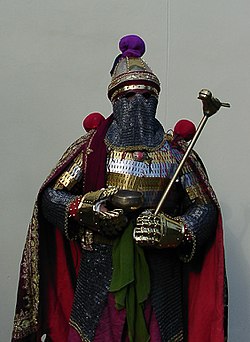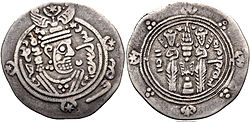Spahbed

| Military of the Sasanian Empire |
|---|
| Armed forces and units |
| Ranks |
| Defense lines |
|
| Conflicts |
|
Spāhbed (also spelled spahbod and spahbad)
The title was also adopted by the
Use in pre-Islamic Iran
The title is attested[
The
Until the early 6th century, there was a single holder of the title, the Ērān-spāhbed, who according to the list of precedence provided by the 9th-century Muslim historian Ya'qubi occupied the fifth position in the court hierarchy.[3] Two spahbeds, both named Raxš, are recorded in Shapur-KZ and Paikuli inscriptions.[2]
The
Khosrow I's reform
To curb the power of the over-mighty generalissimo, Khosrow I—although this reform may already have been planned by his father,
| Name | Command | King | Family | Other titles |
|---|---|---|---|---|
| Chihr-Burzēn ( Simah-i Burzin ) |
East | Khosrow I | Kārin |
|
| Dād-Burzēn-Mihr (Wuzurgmihr) |
East | Hormizd IV | Kārin | aspbed ī pāhlav |
| Wahrām Ādurmāh (Bahram-i Mah Adhar) |
South | Khosrow I & Hormizd IV | Unknown | šahr-hazāruft (under Hormizd IV only), nēwānbed, šābestan |
| Wēh-Shāpūr | South | Khosrow I | Unknown | aspbed ī pārsīg |
| Pīrag | South | Khosrow II | Mihrān |
Shahrwarāz |
| Wistakhm (Vistahm) |
West | Khosrow II & Hormizd IV | Ispahbudhān |
Hazarbed |
| Gōrgōn or Gōrgēn (Golon Mihran) |
North | Khosrow I | Mihrān | |
| Sēd-hōsh (?) | North | Khosrow I | Mihrān | šahr-aspbed |
Other holders of the rank are difficult to identify from the literary sources, since the office of spāhbed was held in tandem with other offices and titles, such as
Islamic period
Tabaristan

During the
The title ispahbadh was also claimed by other lines of local rulers in the region, who claimed distant descent from the Sasanian past: the
Central Asia
In Khurasan, the title survived in usage among the local
In Armenia
The Kingdom of Armenia, which was ruled by a branch of the Parthian Arsacid dynasty, adopted the term first in its Old Persian form, giving Armenian [a]parapet and then again, under Sasanian influence, from the Middle Persian form, giving the form aspahapet. The title was used, as in Persia, for the commander-in-chief of the royal army, and was borne in hereditary right by the Mamikonian family.[3]
In Georgia
The institution of the Georgian rank
According to the medieval Georgian chronicles, the rank of spaspet was introduced by the first king
References
- ISBN 9783406093975
- ^ a b c d e f g h Gyselen (2004)
- ^ a b c d e f g h i j k l m n Bosworth (1978), pp. 207–208
- ISBN 978-1-135-79704-1.
- ^ a b Chaumont (1987), pp. 825–826
- ^ Martindale (1980), p. 169
- ^ Martindale (1992), p. 137
- ^ Pourshariati (2008), pp. 95ff.
- ^ Howard-Johnston, James (2012). "The Late Sasanian Army". Late Antiquity: Eastern Perspectives (Off-print): 87–127 – via Academia.
- ^ Pourshariati (2008), pp. 94–95
- ^ Pourshariati (2008), pp. 98–101, 470 (Table 6.3)
- ^ Kennedy (2007), p. 187
- ^ Kennedy (2007), pp. 178–179, 192
- ^ Madelung (1975), pp. 198–200
- ^ Madelung (1975), pp. 200–202
- ISBN 0-684-16760-3.
Bibliography
- OCLC 758278456.
- Chaumont, M. L. (1987). "ASTABED". In ISBN 978-0-71009-108-6.
- ISBN 978-1-85043-898-4.
- Gyselen, Rika (1996–2021). "SPĀHBED". In Yarshater, Ehsan (ed.). Encyclopædia Iranica, Online Edition. Encyclopædia Iranica Foundation. Retrieved 30 November 2012.
- ISBN 978-0-306-81740-3.
- ISBN 0-521-20093-8.
- ISBN 0-521-20159-4.
- ISBN 0-521-20160-8.
- Pourshariati, Parvaneh (2008). Decline and Fall of the Sasanian Empire: The Sasanian-Parthian Confederacy and the Arab Conquest of Iran. London and New York: I.B. Tauris. ISBN 978-1-84511-645-3.
